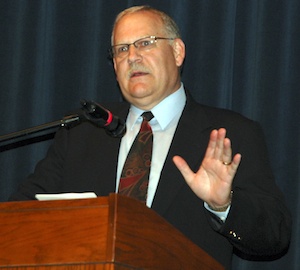ARLINGTON — Firefighters from Marysville, Getchell, Tulalip Bay, Arlington, Arlington Heights, Silvana and Lakewood were among those representing 14 fire districts at a special meeting on Thursday, Aug. 30, to discuss the future of fire and emergency medical services in Arlington and North Snohomish County as a whole.
Arlington Mayor Barbara Tolbert introduced Don Bivens, an emergency services consultant with 30 years of experience in the fire service, as he presented a program in the Linda M. Byrnes Performing Arts Center on how the fire districts in attendance might be able to partner and/or pool their resources to maintain and perhaps even expand their levels of service in the face of ever-increasing demands and diminishing resources.
Bivens retired from the Clark County Fire District in Vancouver, Wash., in 2010, and acknowledged that public expectations of fire and EMS are escalating while state and federal dollars are drying up in the midst of ongoing economic troubles.
“What’s the upside of regionalizing?” Bivens asked rhetorically. “I can’t say you’ll always save money, but you’ll gain significant opportunities to reduce costs, especially as you benefit from economies of scale.”
Bivens touted the clout that regionalization would lend to the agencies involved, and explained that it can be accomplished via a merger of any number of fire districts, an annexation of a city, a contractual consolidation of the districts’ administrations or functions, an operational consolation which would retain the districts’ separate administrations, an organizational consolidation of one agency contracting the other agency’s full services, or the implementation of a regional fire authority.
“Regional fire authorities are catching on nationally,” Bivens said. “It’s as close to a merger between a city and a fire district as you can get. The organizations don’t go away, and there’s not really any more government, since it adds responsibilities to the existing people.”
Bivens admitted that the process time for instituting a regional fire authority is “intensive,” but presented regionalization as a chance to reevaluate longstanding practices.
“It’s an excuse for a do-over, to decide how you might provide your services differently,” Bivens said. “You can try and get creative, because just raising taxes and making cuts is a not a sustainable strategy.”
When asked how much a feasibility study for regionalization would cost, Bivens noted that the one he’d witnessed in Clark County, which involved eight agencies and four cities, ran to $232,000, but declined to speculate for North Snohomish County, beyond pointing out that the number of agencies involved would affect the price. When Arlington City Council member Debora Nelson asked how wide-ranging a regional fire authority should be geographically, Bivens asserted that the included fire districts’ boundaries should be coextensive, or at least within the same sphere of influence.
“Closer is better,” Bivens said. “Touching is best. The more agencies you have, the more moving parts you have. A handful of agencies are very doable, but past a certain point, the price goes up and it becomes more difficult.”
At the same time, Bivens cited better grant funding as an advantage of regionalized fire services, and advised the fire districts to have an evaluation conducted by a third-party outside agency, to counteract what he saw as “built-in biases” that each agency would have when evaluating themselves.
“This is all too overwhelming to try and zero in on any specific details now,” said Tulalip Bay Fire Commissioner Bill Dobler, when asked for his thoughts on the options that Bivens outlined. “We’re just a little district sitting out on the edge. Just to survive, we already have to work with others.”
Arlington Fire Chief Bruce Stedman emphasized that the evening’s meeting was simply an exploratory session, and that no plans have been made in any direction.
“It’s important for us all to have completely open minds at this point, to figure out what’s best for all our communities,” Stedman said. “It’s encouraging to see 14 fire districts participating in this discussion. Because of the economy, we need to have these discussions now, so that we can make decisions that will allow us to move forward.”
“These all seem like relatively reasonable, responsible alternatives,” said Marysville Fire Assistant Chief Martin McFalls, who shared Stedman and Dobler’s reticence for narrowing the options down at this point. “We’re all seeking the best bang for our buck nowadays, and our communities need to know that. We can’t take their support for granted.”



